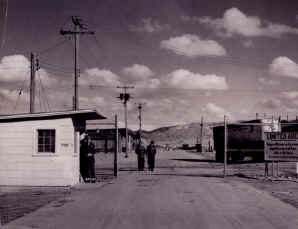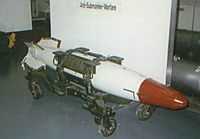Naval Weapons Evaluation Facility facts for kids
The Naval Weapons Evaluation Facility (NWEF) was a special place that helped the United States Navy during the Cold War. Its main job was to make sure Navy airplanes could safely carry and use nuclear weapons.
Contents
How NWEF Started
The story of NWEF began during World War II. The United States Army Air Corps started using Kirtland Field near Albuquerque, New Mexico. Right next to it, Sandia Base was set up for training.
After the war, in 1945, some groups from the Los Alamos National Laboratory moved to Sandia Base. They wanted to use the flight test areas at Kirtland Field. Kirtland Field became Kirtland Air Force Base in 1947.
In 1949, the United States Air Force created a special command at Kirtland Air Force Base. The Navy then formed its own small group there. This group's job was to figure out how Navy planes could handle nuclear weapons. They also helped with training and showing how naval equipment worked.
This Navy group was led by Commander Thomas Walker. In 1952, this group got a new name: the Naval Air Special Weapons Facility (NASWF). They started doing special weapon tests at places like the White Sands Missile Range. They worked closely with the United States Atomic Energy Commission.
Growing Mission and New Name
As new types of weapons were developed in the late 1950s, NASWF's job grew. They started working with ballistic missiles, guided missiles, and torpedoes.
In March 1961, NASWF was renamed the Naval Weapons Evaluation Facility (NWEF). Their mission also expanded to include studying how to keep nuclear weapons safe.
The planes used for NWEF testing had a cool thunderbird symbol painted on them. People in Albuquerque even called the NWEF staff the "Rio Grande Navy."
In 1976, NWEF personnel formed the Navy Balloon Team. They did this to help with recruiting during the popular Albuquerque International Balloon Fiesta.
NWEF stopped its operations at Sandia Base in 1993. Its important tasks were then moved to another Navy group, the weapons division of the Naval Air Warfare Center.
What NWEF Tested
NWEF did a lot of important testing to make sure Navy aircraft could handle different weapons.
Early Aircraft and Bombs
At first, NWEF worked on planes like the Douglas A-1 Skyraider, A-3 Skywarrior, and A-4 Skyhawk. They tested these planes with various early nuclear bombs. These included the Mark 4, 5, 6, 7, 8, 12, 15, 18, 27, and 39 bombs.
Later Weapons and Aircraft
As missiles became more common, NWEF tested newer nuclear bombs. These included the B28, B43, B57, and B61 nuclear bombs. They tested these with planes like the Grumman A-6 Intruder, LTV A-7 Corsair II, McDonnell Douglas F-4 Phantom II, and the A-4 Skyhawk.
Anti-Submarine Weapons
NWEF also tested special nuclear depth bombs. These were designed to be used against submarines. The Mk 90 Betty and Mk 101 Lulu bombs were tested with several types of aircraft. These included Lockheed P-2 Neptune, Lockheed P-3 Orion, and Martin P5M Marlin maritime patrol aircraft. They also tested them with the Sikorsky SH-3 Sea King helicopter and the Grumman S-2 Tracker.
The Mk 101 Lulu was even tested for countries in NATO. This included planes like the Canadair CP-107 Argus, Avro Shackleton, and Hawker Siddeley Nimrod. Later, these planes and the Bréguet 1150 Atlantic were tested with the B57 nuclear bomb. The A-1, A-3, and A-4 planes were tested with the Mk 105 Hotpoint anti-submarine weapon.




